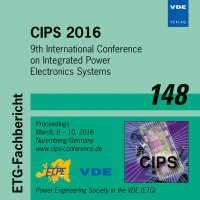Influence of wire material and diameter on the reliability of Al-H11, Al-CR, Al-R and AlX heavy wire bonds during power cycling
Conference: CIPS 2016 - 9th International Conference on Integrated Power Electronics Systems
03/08/2016 - 03/10/2016 at Nürnberg, Deutschland
Proceedings: CIPS 2016
Pages: 6Language: englishTyp: PDF
Personal VDE Members are entitled to a 10% discount on this title
Authors:
Ehrhardt, Christian; Hoefer, Jan; Schneider-Ramelow, Martin (Fraunhofer IZM, Gustav-Meyer-Allee 25, 13355 Berlin, Germany)
Geissler, Ute; Broll, Marian; Lang, Klaus-Dieter (Technical University of Berlin, Gustav-Meyer-Allee 25, 13355 Berlin, Germany)
Schmitz, Stefan (Bond-IQ GmbH, Gustav-Meyer-Allee 25, 13355 Berlin, Germany)
Abstract:
This Paper presents reliability results of aluminum heavy wire bonds during power cycling on MOSFET modules. In order to investigate the effect of the wire material on the reliability different wire alloys like Al-H11, Al-CR, Al-R and AlX were used. Furthermore, the influence of the wire diameter on the lifetime of the power modules was also tested using 125 µm, 300 µm and 400 µm Al-H11 wire diameters. The bonding parameters were optimized for all samples so that a shear code 3 (area of the shear residues between 50 % and 75 %) and shear code 4 (area of the shear residues higher than 75 %) could be set. For lifetime testing active power cycling with different temperature swings (DeltaT = 75 K, 85 K, 95 K and 105 K) were performed. The samples were characterized by shear testing to evaluate the quality of the bonding zone in the initial state and after different intervals. The normalized shear force was plotted as a function of the cycle number. It was shown that the wire diameter has a significant influence on the reliability compared to the standard Al heavy wire material. Only the AlX wires show a distinct increase in lifetime compared to Al-H11, Al-R and Al-CR. A significant higher life time could be achieved using smaller wire dimeters. Microstructure analyzes using electron backscatter diffraction (EBSD) show a district rotated cube (RC) texture with same grain sizes slightly above the chip metallization for all 3 pure Al wire materials.


